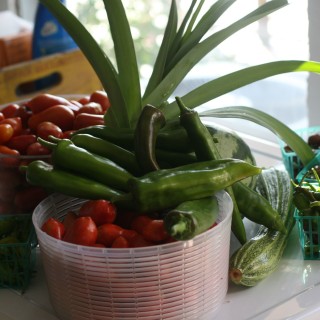(echinacea purpuea started last spring)
Seems a strange time of year to be inspired by writing about gardening, but I guess as fall progresses and the garden is ‘wrapping’ up, it’s nice to look back at our growing season and look forward to the next…
Generally speaking, Scott is the vegetable grower and I am the flower grower around these parts. Generally speaking, Scott grows things from seed and I buy 4″ perennials at the nursery. Before the children came I grew flowers from seed quite a bit, but when I started having my babies there was only so much nurturing I could do. Starting from seeds had to go, for a while at least. Now that our youngest is 3, I started a few things from seed this summer and remarkably the majority of the seedlings have grown and flourished! There is something to be so proud of when you grow a successful plant from seed. First it’s so much more economical and the satisfaction of growing something from nothing is huge.

(hollyhocks started last spring)
In spring I started a tray of both echinacea purpurea and black hollyhocks. I kept them on my washer and dryer which is right in front of a window. Since I do at least one load of laundry a day it was easy to keep an eye on them. Once the threat of the spring bugs where gone, I planted them out with handfuls of Sluggo, copper tape
and even netting over them to protect them. Only one of the echinacea survived, but boy is it a healthy plant. Most of the hollyhocks survived too and growing well in the garden. Strangely enough I planted them all within a few feet of each other, making sure to get them by the drip lines, yet some are just slowly growing while others are three times their size. Not knowing the rhyme or reason, I just sit back happy that none of them are dead!

(hollyhocks started 6 weeks ago and transplanted outside)
Hit by a streak of confidence I started another round of both echinacea and hollyhocks about 6 weeks ago in hopes of doubling my yield of flowers next spring. I grew the black hollyhocks specifically for dying yarn. The book Harvesting Color shows that they give a beautiful blue color, which is a rare color to get without indigo in the natural dye world. I’m curious to see if starting these perennials & biennials last spring versus this fall will show much of a difference once next spring comes.

(echinacea purpurea started six weeks ago, still inside)
For about 9 solid years my flower gardening got very basic and tough love. If the store bought plants didn’t survive with my haphazard watering routine or a soccer ball thrown into it at full force, well, then too bad. However I did feel bad when I looked out my window and saw another dying plant. Now though, I’m able to give a little more to the garden. There’s a saying I heard a while back regarding women trying to balance motherhood and their career. It goes, ‘You can have your cake and eat it too, just not all at once.’ I keep that saying in mind towards a lot of activities that I’d like to be doing, but have to make lunches or drive again to their school instead. All things in good time. You can have happy babies and a thriving garden, but maybe not all at the same time.









Also growing from seeds helps native bees, as nursery plant starts are sprayed…
I was never sure if it was having happy babies, or the multiple Labrador Retrievers that made for the less-than-successful gardening…one heck of a sandbox though!
Good luck with your hollyhocks. I tried dyeing with them this summer, using the recipe from Harvesting color. It’s not actually blue, more greenish, but lovely!